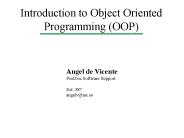Introduction to Object-Oriented Programming in C - PowerPoint PPT Presentation
Title:
Introduction to Object-Oriented Programming in C
Description:
double r(); double phi(); double theta(); protected: double _x, _y, _z; Vector.h ... double r() const; double phi() const; double theta() const; ... – PowerPoint PPT presentation
Number of Views:9
Avg rating:3.0/5.0
Title: Introduction to Object-Oriented Programming in C
1
Introduction to Object-Oriented Programmingin
C
- Vincenzo Innocente
- CERN, Geneva, Switzerland
2
Classes and Objects
- An example of object oriented Programa
video-game
3
Class Vector
- An example un tri-dimentional vector
- With respect to a structure, a class contains
functions beside data
constructor
functions or methods
data
copy constructor
4
Class Vector
- How to use Vector
invoke the constructor
5
Class Vector
- Data access protection
6
Interface and implementation
- Protected data are not accessible outside the
class
Vector.hh
class Vector public Vector(double x, double
y, double z) double x() const double y()
const double z() const double r() const
double phi() const double theta()
const protected double _x, _y, _z
const
Vector.cc
include Vector.h VectorVector(double x,
double y, double z) _x(x), _y(y),
_z(z) double Vectorx() const return _x
double Vectorr() const return sqrt(xx
yy zz)
7
Interface and implementation
- The internal structure of the data (_x, _y, _z)
that represent the objects of the class Vector
are hidden (protected) to the clients of the
class. - The clients do not depend on the internal
structure of the data (as it was the case for
clients of FORTRAN common block) - If the internal structure changes (es. _r,
_theta, _phi), the code using Vector does not
have to be modified.
8
Operators
- It is possible to redefine , -, , , , , .
. .
9
Operators
- Example
redefinition of ltlt
10
Operators
- Example
p
11
Operator overloading
- It is possible to define functions with the same
name but different arguments
12
Static Functions and data
- Some functions can be common to the whole class
13
Templates
- The same definition can be applied to different
types
templateltclass Tgt T sqr(const T x) return x x
templateltclass Tgt T min(const T a, const T b)
return (a lt b ? a b) templateltclass Tgt T
max(const T a, const T b) return (a gt b ? a
b)
recursive
templateltclass Tgt T fact(const T n) return
(n 0 ? 1 n fact(n -
1))
14
Inheritance
- Add methods and attributes to a class
Invoke the constructor of the base class
- Inheritance allows code re-use
15
Inheritance
- A derived class inherits all methods fo the base
class
- DchTrack is a Track with more attributes (_hits)
and new methods (DchHit hit(int n), int hits())
16
Abstract Class
- Classic example Shape
- All objets in the window have common behaviors
which could be considered in abstract - draw, move, enlarge, etc.
17
Abstract classes and virtual function
- Shape is an abstract class because it has pure
virtual methods
Pure virtual methods
18
Abstract classes and virtual functions
- Shape clients do not have to know which of its
derived classes actually implement it.
19
Inheritance
- Careful choosing the correct inheritance
relations could not be trivial. - Is a square a rectangle?
- both_lx and _ly are redundant in Square
- What happen if scaleX or scaleY is invoked?
20
Multiple Inheritance
- A class can inherit from more than one class
21
Surfaces and trajectories
- In tracking is often required to compute the
intersections among curves (tracks) and
superfaces (detector elements)
Intersection(Surface, Trajectory)
Trajectory
Surface
Line
Helix
PolyLine
Plane
Cylinder
etc . . .
etc . . .
22
Surfaces and trajectories
- Interface of various Trajectorys
23
Surfaces and trajectories
- Implementation
24
Surfaces and trajectories
- Interface of the various Surfaces
distance (with sign) of a point form the surface
25
Surfaces and trajectories
- Surface is an abstract class
scalar product between two Vectors
26
Surfaces and trajectories
- Interface of Intersection
forward class declarations
27
Surfaces and trajectories
- Implementation of the algorithm
28
Surfaces and trajectories
- Intersection uses only
- The methods position and direction of a
Trajectory object - The methods distance and derDist of a Surface
object - It is possible to add a new class that models a
new Trajectory or a new Surface and Intersection
continues to work without modifying a single line
of code!
29
Shapes Visitors
- Shapes
30
Shapes Visitors
- Visitors
31
Shapes Visitors
- Main
32
Open/Closed principle (R. Martin)
- A good code has to be
- open to extensions
- closed to modifications
- Modifications of a working code can introduce
defects (bugs) - Object Orientation, with the mechanism of virtual
classes, allows to apply this principle































